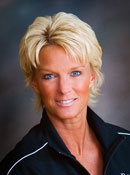Many of us who use the pool are accustomed to a quick workout – put in a few springs, some IM, a few 200’s, and call it a day. We tend to focus on the variety of activity and intensity of the workout, rather than the duration. But distance is a major factor in the success of your swimming workout! When you focus on building speed alone, you may find that you lack the strength training necessary to maintain that speed for a distance. Distance training can also be incredibly useful in triathlon, open water, or really any kind of race training. To get a maximum return on your workout, it’s best to vary the types of workout you complete through the week. For every spring set you do, put in a quick 300-500 yard freestyle. It can even be helpful to set aside an entire workout dedicated to a mile or two at a time. Remember, in the swimming world, we consider 1650 to be a mile. Here’s a starter distance set to get into the swing of things; remember that as you grow stronger, your workouts should increase in difficulty as well. Challenge yourself this summer; train outdoors, in the pool, go for the strokes and distance you’re not comfortable with! The only way to improve is to test yourself, so get to it!
Warm-Up
1×200 swim
1×200 kick with board
1×200 pull with buoy
1×200 sprint
Main Set
1×400 IM at 90% effort
1×200 freestyle easy
1×500 freestyle build to spring
2×100 choice easy
4×50 freestyle spring
Cool Down
1×300 freestyle cool down pace
Total Yardage: 2600

 Junior Racquetball Camp will take place July 23-26. The camp is taught by Professional Instructor, Wanda Collins. This year we’ll have special guests: BAC Junior Players who have represented the State at Junior Nationals. The Camp consists of Racquetball basics including strokes, servers, off the back wall shots, game strategy, foot drills, speed and agility exercises, camp shirts, and a mini-tournament on Thursday.
Junior Racquetball Camp will take place July 23-26. The camp is taught by Professional Instructor, Wanda Collins. This year we’ll have special guests: BAC Junior Players who have represented the State at Junior Nationals. The Camp consists of Racquetball basics including strokes, servers, off the back wall shots, game strategy, foot drills, speed and agility exercises, camp shirts, and a mini-tournament on Thursday. The “Stork” is a static hip exercise for strengthening and activating the lateral Gluteals, Gluteus Medius, Gluteuas Minimus, and the Piriformis muscles. This set of external hip rotators are responsible for abducting the leg out away from the body, rotating your leg outward, and stabilizing your femur at the hip. Non-activity and injury can cause this group to become weak which can affect the overall performance of your hip complex, affecting your gait and in some cases cause knee, hip, and lower back pain.
The “Stork” is a static hip exercise for strengthening and activating the lateral Gluteals, Gluteus Medius, Gluteuas Minimus, and the Piriformis muscles. This set of external hip rotators are responsible for abducting the leg out away from the body, rotating your leg outward, and stabilizing your femur at the hip. Non-activity and injury can cause this group to become weak which can affect the overall performance of your hip complex, affecting your gait and in some cases cause knee, hip, and lower back pain. The Static Hip Series is called the “Donkey Kick”. The “Donkey Kick” is a static hip exercise for strengthening and activating the Gluteus Maximus and the Hamstrings. The Gluteus Maximus and the Hamstring muscles work in concert with each other to extend your hip. Extremely important muscles for gait in walking and in running. Injury and inactivity can dramatically affect the performance of these two groups which in some cases may cause modifications to gait and running mechanics, increasing the chances of injury and or pain.
The Static Hip Series is called the “Donkey Kick”. The “Donkey Kick” is a static hip exercise for strengthening and activating the Gluteus Maximus and the Hamstrings. The Gluteus Maximus and the Hamstring muscles work in concert with each other to extend your hip. Extremely important muscles for gait in walking and in running. Injury and inactivity can dramatically affect the performance of these two groups which in some cases may cause modifications to gait and running mechanics, increasing the chances of injury and or pain. Jeri Winterburn has been teaching fitness classes for over 35 years. She is also a syndicated fitness columnist and wrote weekly columns for the Bellingham Herald for several years. Jeri has been featured in a R.I.P.P.E.D video available online.
Jeri Winterburn has been teaching fitness classes for over 35 years. She is also a syndicated fitness columnist and wrote weekly columns for the Bellingham Herald for several years. Jeri has been featured in a R.I.P.P.E.D video available online.
 The 4-Letter Word! I know, it’s not really 4 letters nor is it a real word. But when you’re doing it, there are plenty of 4 letter words that are used, at least by me. Rehab means I’m injured and not doing what I want to be doing. Rehab also means pushing muscles, finding new muscles and is generally boring and monotonous. I know what I’m talking about because I’ve done a lot of it.
The 4-Letter Word! I know, it’s not really 4 letters nor is it a real word. But when you’re doing it, there are plenty of 4 letter words that are used, at least by me. Rehab means I’m injured and not doing what I want to be doing. Rehab also means pushing muscles, finding new muscles and is generally boring and monotonous. I know what I’m talking about because I’ve done a lot of it.